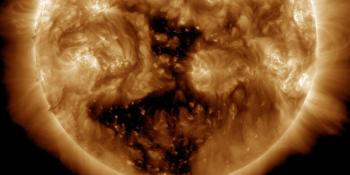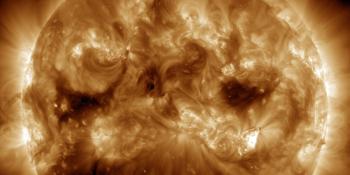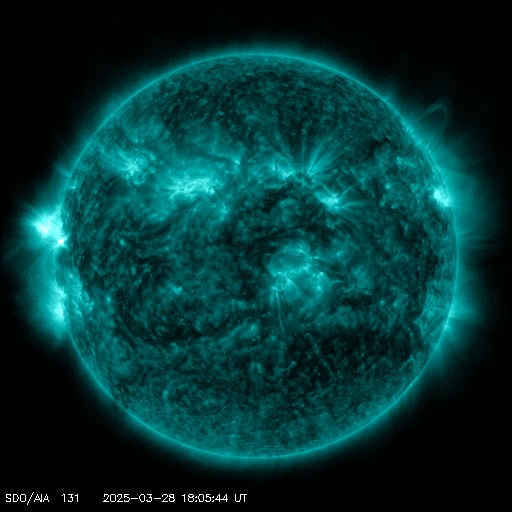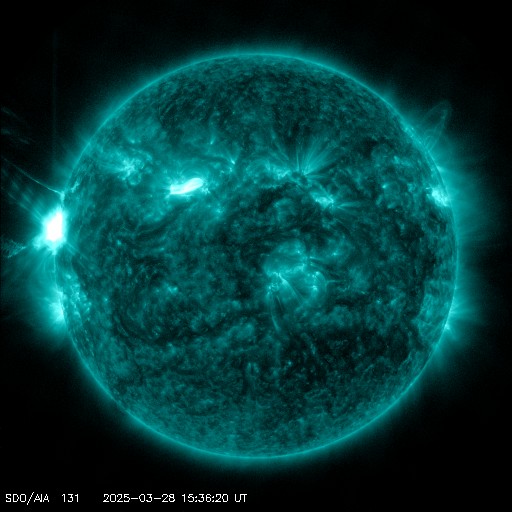Viewing archive of Friday, 28 June 2024
Geophysical report
Solar and Geophysical Activity Summary 2024 Jun 28 0245 UTCPrepared by the NOAA © SWPC and processed by SpaceWeatherLive.com
Joint USAF/NOAA Solar and Geophysical Activity Summary
SGAS Number 180 Issued at 0245Z on 28 Jun 2024 This report is compiled from data received at SWO on 27 JunA. Energetic Events
Begin Max End Rgn Loc Xray Op 245MHz 10cm Sweep 0109 0118 0125 3723 C3.1 440 0513 0513 0513 570 0559 0559 0559 120 0635 0635 0635 710 1330 1331 1331 200 2243 2244 2245 130 2338 2347 2351 3730 C6.6 850
B. Proton Events
None
C. Geomagnetic Activity Summary
The geomagnetic field was at quiet
to unsettled levels.
D. Stratwarm
Not available
E. Daily Indices: (real-time preliminary/estimated values)
10 cm 183 SSN 146 Afr/Ap 011/009 X-ray Background C1.2 Daily Proton Fluence (flux accumulation over 24 hrs) GT 1 MeV 1.5e+06 GT 10 MeV 1.7e+04 p/(cm2-ster-day) (GOES-18 satellite synchronous orbit W137 degrees) Daily Electron Fluence GT 2 MeV 1.10e+06 e/(cm2-ster-day) (GOES-16 satellite synchronous orbit W75 degrees) 3 Hour K-indices Boulder 3 2 1 2 2 3 3 6 Planetary 2 1 1 1 2 3 3 3
F. Comments
None
All times in UTC
Current data suggests there is a slight possibility for aurora to appear at the following high latitude regions in the near future
Norilsk, VorkutaLatest news
Latest forum messages
AR4046 57The multiple event last week. 3AR4043 36Incoming & Unnumbered Active Regions 1653Filaments and prominences 748
More topicsSupport SpaceWeatherLive.com!
A lot of people come to SpaceWeatherLive to follow the Sun's activity or if there is aurora to be seen, but with more traffic comes higher server costs. Consider a donation if you enjoy SpaceWeatherLive so we can keep the website online!

Latest alerts
18:21 UTC - Solar flare
Moderate M1.03 flare
18:03 UTC - Radio Blackout
Minor R1 radio blackout in progress (≥M1 - current: M1)
15:45 UTC - 10cm Radio Burst
Begin Time: 28/02/2025 15:06 UTC Maximum Time: 28/02/2025 15:14 UTC Duration: 24 minutes. Peak flux: 380 sfu
15:45 UTC - Type IV Radio Emission
Begin Time: 28/03/2025 15:14 UTC
15:42 UTC - Solar flare
Major X1.14 flare from sunspot region 4046
Space weather facts
| Last X-flare | 2025/03/28 | X1.1 |
| Last M-flare | 2025/03/27 | M2.0 |
| Last geomagnetic storm | 2025/03/27 | Kp5 (G1) |
| Spotless days | |
|---|---|
| Last spotless day | 2022/06/08 |
| Monthly mean Sunspot Number | |
|---|---|
| February 2025 | 154.6 +17.6 |
| March 2025 | 130 -24.6 |
| Last 30 days | 130 -22.2 |




